Vizio Thin+Light CT15: Something New and Edgy
by Vivek Gowri on February 14, 2013 9:00 AM EST- Posted in
- Laptops
- Intel
- IPS
- Ivy Bridge
- Vizio
- Ultraportable
- Ultrabook
I’m going to run through our benchmark suite pretty quickly, because we’re pretty familiar with the ultra low voltage Ivy Bridge parts by now. The i7-3517U is the most common ULV i7 SKU, and the second most common Ultrabook part after the i5-3317U. Clock speed of 1.9GHz, max turbo of 3.0GHz, and HD4000 are all part of the package.
| Laptop Configuration Overview | ||||
| Laptop | CPU | Graphics | Storage | Battery |
| Acer Aspire S3-951-6432 | Intel i7-2637M | HD3000 | 256GB SSD | 38Wh |
| Acer Aspire S5-391-9860 | Intel i7-3517U | HD4000 | 2x128GB SSD | 35Wh |
| Acer Aspire S7-391-9886 | Intel i7-3517U | HD4000 | 2x128GB SSD | 35Wh |
| Apple MacBook Air 13 (Mid-2012) | Intel i5-3427U | HD4000 | 256GB SSD | 50Wh |
| ASUS Zenbook Prime UX31A-DB71 | Intel i7-3517U | HD4000 | 256GB SSD | 50Wh |
| Dell XPS 13 | Intel i7-2637M | HD3000 | 256GB SSD | 47Wh |
| HP Envy 14 Spectre | Intel i7-3667U | HD4000 | 2x128GB SSDs | 56Wh |
| HP Folio 13 | Intel i5-2467M | HD3000 | 128GB SSD | 60Wh |
| Intel IVB Ultrabook Prototype | Intel i5-3427U | HD4000 | 240GB SSD | 47Wh |
| Toshiba Satellite U845-S406 | Intel i5-3317U | HD4000 | 500+32GB Hybrid | 54Wh |
| Toshiba Satellite U845W-S410 | Intel i5-3317U | HD4000 | 500+32GB Hybrid | 54Wh |
| Vizio Thin+Light CT15-A5 | Intel i7-3517U | HD4000 | 256GB SSD | 52Wh |
Performance is very much in line with the Acer Aspire S7 that Jarred reviewed, with the main difference between the two systems being Vizio’s single Toshiba 256GB SSD versus Acer’s two 128GB Lite-On drives in RAID 0 and the extra RAM in the Acer. Again, being limited to 4GB of memory in the Vizio is a bit annoying, but in the grand scheme probably not a huge deal for most. I’ve recently been dealing with a number of systems with only 4GB RAM—MacBook Air, Surface Pro, other Ivy Bridge tablets, my trusty ASUS Zenbook Prime—and they’ve all held up well in casual use. I think anything less than 8GB RAM is a bit rough for any serious system, but 4GB is a livable limit for a machine in this class.
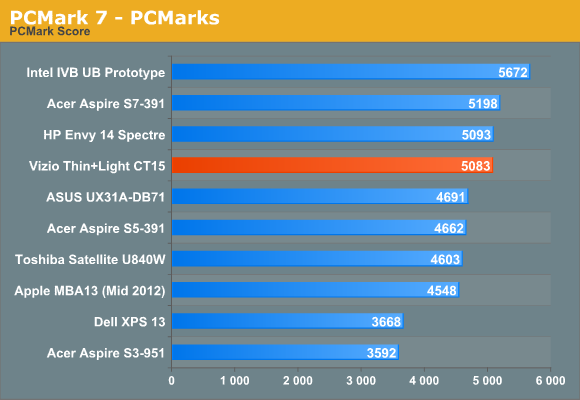
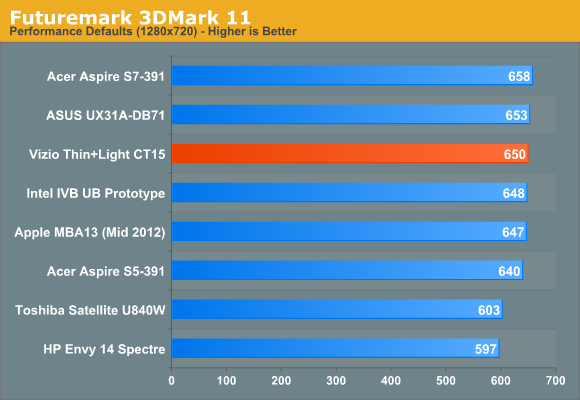
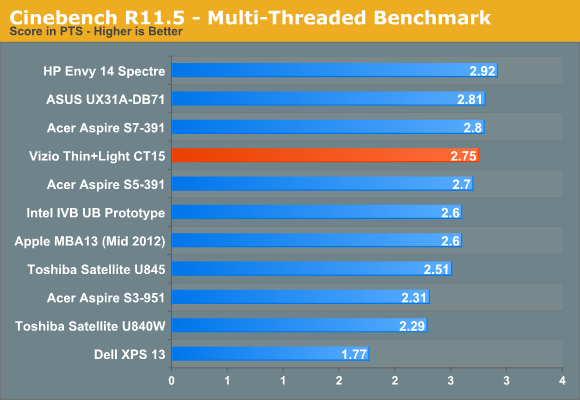
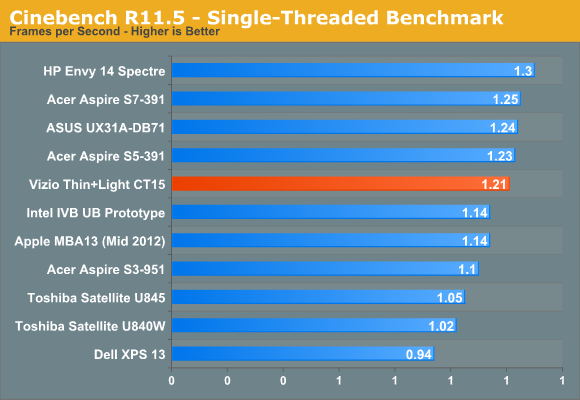
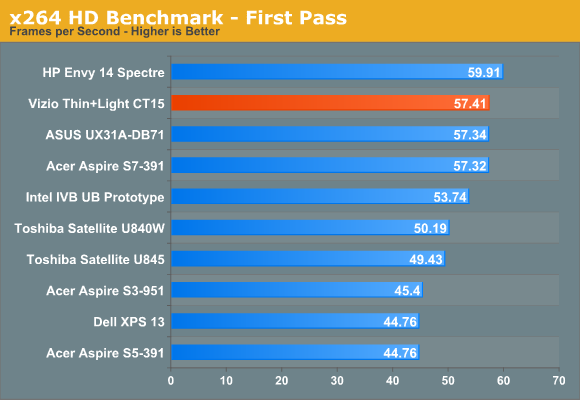
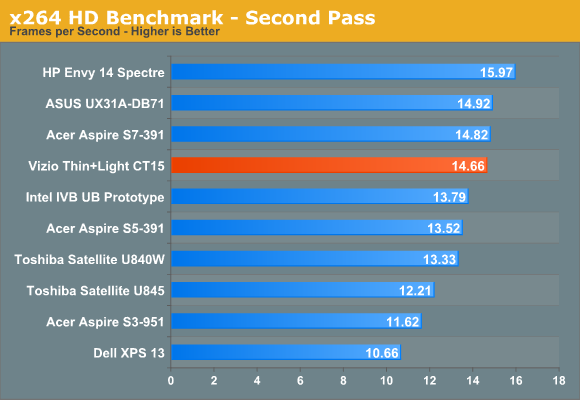
The CT15 has a 52Wh 6-cell li-poly battery that theoretically gives it decent battery life. Unfortunately, it doesn’t really hold up to that in real life, though you can point to a few reasons for that. We saw around five hours in our ideal case test and a hair over four in our internet test that tends to be a better barometer of what you can expect in typical daily use.
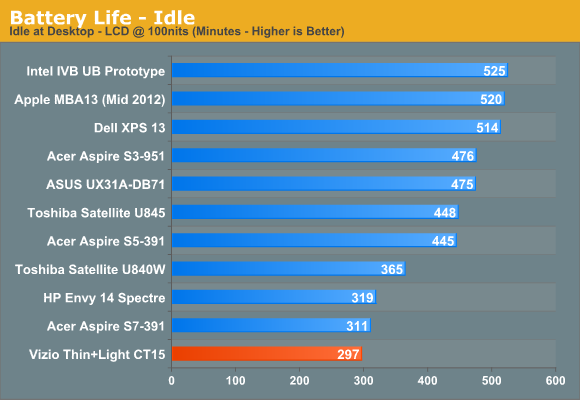
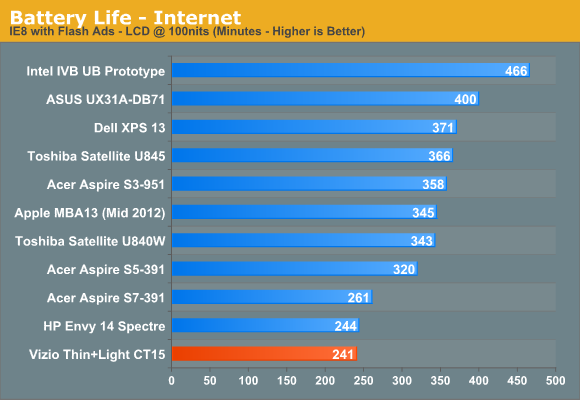

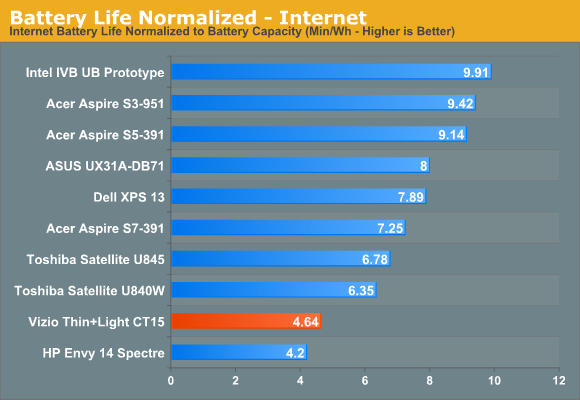
Those numbers seem low, as does the three hours and change in our HD video benchmark, but I think the main culprit is the 1080p 15.6” display. The increase in display size and resolution easily accounts for the increase in overall power draw compared to the 13” Ultrabooks we’ve seen thus far. Other than the Vizio and the HP Envy Spectre, every other notebook in the graphs is a 13” Ultrabook, which is why both the Vizio and the HP come off looking quite poor. Apple went with a 95Wh battery for the Retina MacBook Pro to end up at the 7 hour mark, versus 77.5Wh for the regular 15” MBP and 63.5Wh for the 13” (all three of which end up in the 7-8 hour range for battery life) so you can see how the 52Wh battery results in a relatively low runtime even with a ULV processor.
This issue gets fixed in the next-gen touchscreen Thin+Light, which has “nearly double” the capacity. I doubt it gets to the 100Wh mark, but even if it ends up near the 15” MacBook Pro in terms of capacity, it should be good enough for something along the lines of 6-7 hours of real world usage.










55 Comments
View All Comments
ChronoReverse - Thursday, February 14, 2013 - link
So what's the typing experience on the keyboard? That's more interesting than knowing the unit flexes (when relating to how the typing goes).What's the key spacing? Any weird key positions? How's the key response (rubber dome mushy or springy?)?
Frankly, the non-use of chiclets is the plus but I need to know how it actually types.
GiGoLo - Thursday, February 14, 2013 - link
i'm pretty nitpicky when it comes to keyboards (went through 4 different mechanicals with different types of switches before settling on one), and I can say the typing on this vizio unit was pretty poor. The keyboard itself started to get slightly bowed after just a few weeks, some keys were super sensitive while others were not, and the left CTRL and ALT keys would often take several tries before it would respond (might've just been a defective unit, but can't really tell)Kudos to vizio for being one of the few PC manufacturers to use high res screens (infuriates me to find these awesome spec'd ultrabooks with 1366x768!)
For me though, the true deal breaker was lack of Wireless Display. This to me is one of Intel's most overlooked (and least advertised) gems. Horrible for gaming, but works great for streaming media, presentations, slideshows, or even just an extended monitor
ChronoReverse - Thursday, February 14, 2013 - link
Okay that sounds terrible. Uneven key response is unacceptable for sure. Anyone else with experience? I wonder if it's just a single defective unit like you surmise.VivekGowri - Thursday, February 14, 2013 - link
I wish WiDi had taken off. It's awesome, right? I do love that every system with an Intel CPU and WiFi module is WiDi capable, I don't love that Vizio went Atheros with the CT15.The typing experience is fine, except that the keyboard flexes like hell. The sizing of the auxiliary keys is weird (the shift key especially seems oddly large) but it takes like 5 minutes to get used to. Spacing is fine, it's not hard to move back and forth between it and my other array of systems. The response is kinda springy, but the feedback isn't that positive, and the flex doesn't help with that at all. It's not that pleasant of a typing experience, not an untenable one or a deal breakingly-bad one, but still not a good one. And that's about all you can say for it.
Penti - Thursday, February 14, 2013 - link
They can activate Miracast which is based on WiDi, should take of this year and Intel has supported it for a while.blueboy11 - Friday, February 15, 2013 - link
Except that my Toshiba laptop that I currently use that's 3 years old and counting doesn't have the dual Wi-Fi that I'm currently looking for in a laptop (although I do have to admit that it does occasionally disconnect from the Internet at times but it's rare), along with 1080p matte display and even the anemic ports (which imo is a MAJOR improvement from what I have) is worth it. We need to start seeing some of these specs on more laptops, especially the IPS display, which is desperately needed on most laptops, which should be standard on most if not all laptops...MobiusStrip - Sunday, February 17, 2013 - link
They should also be lauded for using a MATTE SCREEN.Glossy screens are the biggest regression in computing ever. Moronic.
Sufo - Monday, February 18, 2013 - link
Depends on the quality of the anti-glare coating. Glossy screens are a lot nicer to watch movies on due to the free boost to black depth, not to mention essential for touch enabled devices. Overall, I prefer matte finish, but "biggest regression in computing ever" is a vast overstatement.Voldenuit - Thursday, February 14, 2013 - link
A thousand dollar laptop with (non-upgradeable) 4 GB of RAM and poor battery life gets a recommendation?If anything, Vizio should be raked over the coals for their RAM configuration, not lauded. Not just the size, but also the fact that it is soldered on.
Props for the 1080p IPS panel, but 4 GB is not enough in a premium product. Microsoft erred here with the Surface Pro, and Vizio did it too. Granted, Win8 is very efficient with resources, but that doesn't help users when their legacy software is still bloated and RAM-hungry (Adobe, I'm looking at you).
With 6-8GB as the default configuration, Vizio could have hit it out the park for users who want a high quality screen and are unconcerned about the limited mobility.
cknobman - Thursday, February 14, 2013 - link
The less than 4 hours of battery life is a real deal breaker for me.Its a shame because at the price this just might have been on my short list.